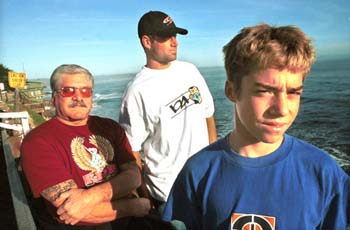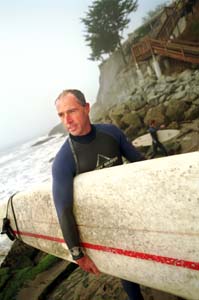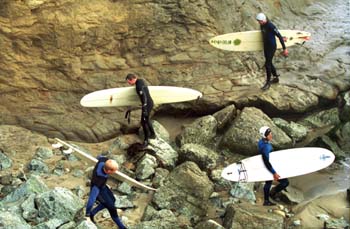![[Metroactive Features]](http://metroactive.com/features/gifs/feat468.gif)
[ Features Index | San Jose | Metroactive Central | Archives ]
Generation Gap: Longtime local surfers like Tony Mikas and sons Shane Barry and Tony Mikas Jr. resent the dotcommer surfers 'with an attitude' who they say are not properly respectful of the often-unspoken rules of the water.
Surfin' Turf
Dotcommers who move to Santa Cruz to take up surfing the waves instead of the Net aren't exactly getting the welcome wagon
By Kelly Luker
SUE TOOK HER BOYFRIEND, Steve Ashley, to the emergency room for stitches after he was jumped for trying to catch some waves last year. Called out onto the beach after an argument about who goes first, Ashley found himself outnumbered, and the next thing he knew, he was coming back to consciousness with a split lip and a busted-up surfboard.
It's not that fighting is anything new in the world of surfing. After living near Santa Cruz' Pleasure Point for the better part of 30 years, I know territorial spats to be as much a part of surf life as beer and Sex Wax. But there's something new going on, my friend Sue insists. It's a group of young punks on shortboards gang-jumping guys like 48-year-old Ashley--without ever having seen him before.
Ashley lives in Boulder Creek and is a writer. His earnings are a far cry from the Silicon Valley riches; unfortunately, being older and on a longboard, he could be mistaken for one of the surf world's most despised aquatic creatures--the dotcommer.
"They hate San Jose surfers the most," snorts a Santa Cruz sheriff's deputy who also surfs, "because they're kooks and they get in the fuckin' way."
Such has always been the lament, in one way or another, of Santa Cruzans who lay claim to the beach and its waters because they live on the western side of the Coastal Range.
It's an old refrain, harking back to the '60s, when retired beach residents were miffed over the hippie and surfer infestations, and then again in the '70s, when the new invaders staked their claim with the spray-painted slogan "Valley Bug Out" on the last Los Gatos overpass over Highway 17.
Nowadays, the poster child for Why Surfing Went to Hell seems to have more to do with money and high tech and that large, amorphous entity: Silicon Valley.
Is it any wonder that, as dotcommers buy up Santa Cruz property at megahertz speed, the turf war seems to be heating up?
Battery Charger
A FEW WEEKS LATER, at a potluck over at my former husband's sister's house, I run into Shane Barry, her husband's son from a former marriage. Following some fin-de-siècle California genealogy, that would probably make him a distant relative. The last time I saw Barry, he was a gangly, adolescent surf rat, the quintessential "troubled youth" determined to give his family prematurely gray hair.
He is now a tall and good-looking 30 years old, but when we get to talking about the surf scene, it seems that trouble still finds him. Barry fills me in on his court date a few days earlier for battery on a fellow surfer from Fremont. He says, first off, he didn't hit the guy, even though he was a longboarder who was surfing much too recklessly and almost ran over Barry's little brother in the water. But Barry will admit to dinging the guy's surfboard with the tip of his. Hell yeah, there's a problem out there, he agrees, but it's not him or his shortboarding friends. It's the valley kooks and dotcommers on big boards that insist on muscling in on the good waves.
Barry talks about those from the other side of the Summit the way good ol' Southern boys used to talk about the "black problem." While he claims that he gets along okay with San Jose surfers who are properly respectful, it's the others who are asking for trouble. "They come over with an attitude," Barry says of the newly minted, "with their nice BMWs or whatever."
The Long and Short of It
ON A FALL Sunday afternoon, the sun is fighting hard to get the upper hand from a chilly November breeze that's blowing in across Monterey Bay. It's left a mirror-bright clarity in its wake that stretches to the horizon, thrusting the Moss Landing power plant smokestacks into sharp relief.
From Knucklehead Curve near 30th to Pervert's Perch around 38th and on to the Hook by 41st, East Cliff Drive in Santa Cruz is a surfing suburbia--a series of breaks appealing to surfers of all levels, ages, board lengths and intentions.
Maybe it's the view across the bay, or the water itself, but most eyes are drawn to the wet-suited, board-straddling pack below. Somewhere between 50 and 60 surfers are trying to lay claim to about six perfect yards of break at Second Peak, one of the three prime surf spots along this 11-block stretch. With the precision of surgeons, they slice within inches of each other, juggling and struggling for a 30-second thrill.
Second Peak is one of the main flashpoints in this longboard/shortboard battle, sides whose warriors are roughly--very roughly--divided between old and young.
"Up until the '60s or '70s, only longboards existed," says Mike Locatelli, retail manager for the Santa Cruz-based O'Neill surf shop, of the surfboard's evolution from long to short and back again. A surfer most of his life, Locatelli knows the history of both the surfboard and the local surfing scene.
"Then shortboards came into play," he explains, "and by the '80s, no one longboarded."
For good reason.
"You could do so much more on a shortboard than you could possibly dream of doing on a longboard," says Locatelli.
Surfboards which had traditionally been 10 feet long and weighed as much as 50 pounds were shrinking to 6 or 7 feet and now weighing less than five pounds.
But managing the waves with five pounds of fiberglass demanded a whole new level of skill, agility and speed from its riders. At the same time, longboarding baby boomers got jobs, got married and got out, leaving the water to their offspring and younger brothers.
But something happened around five years ago. Maybe the kids grew up, maybe the IPO took off, but suddenly, the older generation found time to get back in the water. On longboards. It might have been nostalgia, but more likely, Locatelli nails the longboard's resurgence with this observation: "It's really hard to surf on a shortboard when you're overweight and older."
Whatever the reason, longboards blew up--and so did the water wars.
Photograph by George Sakkestad
Peak Experience
ASHLEY WAS OUT AT Second Peak, and says he "exchanged words" with a shortboarder who said Ashley was in his way. The shortboarder goaded him into coming onto the beach to fight. Once there, he was cowardly "cold-cocked" by the guy's friend, who came up behind him.
"It wasn't an isolated incident," says Ashley of his altercation.
Although he filed a police report, Ashley has not been pleased with the response from the Santa Cruz Sheriff's Department since then.
"I was told that nothing would come of this [police report]," says Ashley. "And there is little police supervision at the beaches."
He has tried to get other older surfers together to address the problem, which he says is limited to maybe a half dozen young punks.
"It's a group of five or six guys in their early 20s," says Ashley. "They play the age thing. The attacks are very common. It starts with name-calling, then a shortboarder will paddle over and hound the person until they go to the beach. The [younger guy] will tell [the longboarder that the younger shortboarder is] underage and 'if you hit me, I'll sue the hell out of you.' Then two or three will jump him.
"Anyone who goes surfing will witness violence. The hostility has escalated."
Santa Cruz Sheriff Lt. Len Lofano says that if water fights are on the upswing, he isn't aware of it. Lofano, who patrolled the Live Oak district that encompasses Pleasure Point before becoming head of the sheriff's patrol unit, believes that hostility goes with the territory.
"Basically, we have a group of people who live in and around Pleasure Point who are territorial," Lofano says. "But what's unusual about this neighborhood is it's the centerpiece for the beaches. There's going to be clashes."
Lofano says that there were problems a few years ago in Pleasure Point, but that the Sheriff's Department moved in and cleaned it up.
"They were mainly fledgling alcoholics," Lofano says of those causing trouble. "They didn't surf that much, but intimidated the senior citizens and hooted at the women."
Another well-known surfer agrees that the Sheriff's Department has kept trouble under control and the longboard-shortboard dispute has actually toned down.
"It's mellowed," says Pat Farley, who has been surfing Santa Cruz waves for 40 years. "The Sheriff's Department cracked down."
There are still "isolated instances," Farley says. "You have guys with no etiquette going out on longboards and grabbing everything."
What makes surfing intolerable now, says Farley, is "now we have the dotcommers. They treat surfing like work--they don't care [about the sport], they just want to get to the top."
Not a Pleasure
IT HASN'T MELLOWED OUT as far as Tom Balch is concerned. The Boulder Creek resident got in a near-fight a couple of years ago with a shortboarder, and says he no longer surfs at Pleasure Point because of the hostility.
"The bias that some shortboarders have is that it's a bunch of old men hogging the waves," Balch says. He also questions why the Sheriff's Department is not more aggressive.
"Are [the sheriffs] waiting for someone to get seriously hurt?" Balch wonders.
The crowds and attitude have driven Balch to the beaches up north, where the danger of sharks is preferable to that of punch-throwing punks.
That's just fine with Shane Barry, who has little tolerance for the longboarders who he thinks steal his waves.
"Longboarders can sit further back on waves so they can catch them first," explains Barry, who has been surfing 20-plus years and manages the surf team that represents Surf Tech, the Randy French surfboard company. "You don't have to be that coordinated to ride a longboard."
Barry explains the rules of wave etiquette, which the longboarder he was cited for assaulting continually broke that afternoon. First the longboarder "burned" Barry's friend Tim, then Barry, for the wave that was rightfully theirs. Then he cut too close to Barry's 15-year-old brother Tony.
After a "harsh verbal" encounter, Barry says he paddled over and dinged the other guy's board with his.
Although the longboarder--listed as a Fremont resident--could not be reached for comment, the police report he filed is telling: "[He] said he has been surfing this location for numerous years and over the last few years there has been an ongoing problem on the water between the younger generation and the older generation," reads the report. "[He] then said it was between the 'long boarders' and the 'short boarders.'"
Listening to two sides of the generational and surfboard-length gap, it's tempting to side up with the longboarders.
In both of these cases, the longboarders had years of surfing experience. Ashley is older, articulate and a respected member of the community for his volunteer activities. Barry, although he says he now has it together, is candid about his extensive rap sheet and former junkie life.
But like it or not, Ashley and Barry are merely bit players in a drama that's being rewritten to almost nobody's liking. For one thing, the stage is getting much too crowded.
Missing the Point: When the surf is up at hot spots along the coast, hundreds of surfers from both sides of the hill vie for waves, often setting the stage for arguments.
Boards in the 'Hood
ACTUALLY, Dennis Godfrey has a better metaphor.
"Too many rats in the cage," says Godfrey, who has lived at and surfed off Pleasure Point for more than 20 years. Godfrey, who continues to ride shortboards even as he approaches the advanced age of 50, has a little wider view of the turmoil in surfing from playing host to all points of view at a weekly Bible study in his house.
"It's not that there's more problems," he observes, "just different problems."
The influx of too many people in the water has disrupted the intricate pattern of interaction once understood by a select few.
"There are too many unspoken rules that not everyone knows," says Godfrey. "There's an unspoken pecking order of who gets the waves. If you don't know the rules, you're walking into a buzz saw."
Although he's referring to life in the water, Godfrey has also offered an apt description of life in any close-knit community. Like Pleasure Point. Or what used to be Pleasure Point.
"Pleasure Point was one of the last surf ghettos in California," remembers Godfrey. "All of a sudden this money came in. Now, on a weekly basis, I would hear guys saying they've been living in a house for 15 years and the house is sold."
No matter how shiny and pretty the newly refurbished houses look, gentrification always exacts a price. In this case, it has cost people like Dennis Godfrey and Shane Barry their neighborhood.
"I remember when there were 10 surfers out there," says Barry, gesturing in the direction of the Hook. "Now they all come with an attitude in their nice BMW or whatever."
Barry knew all 10 of those surfers, as well as all of his neighbors. He has lived his whole life on 34th Avenue next to the water, the stepson of well-known surfer and board maker Tony Mikus.
Barry laughs as he describes the hazing rituals that he and his friends suffered as they moved from "grommet"--young surfer--to adulthood.
Most of those friends are gone now, forced out by skyrocketing rents and ramshackle beach dumps selling in the seven-figure range. If the culprit has a face, it is New Money from Silicon Valley.
"We used to call them 'Valley kooks,'" says Godfrey. "The new phrase is 'dotcommer.'"
Used loosely, it fits most anyone who's a stranger, who's on a longboard and who's older. It has become a catchphrase for the boogieman that stole someone's wave or someone's neighborhood, depending on the day.
Maybe the sheriffs will paddle out and start patrolling the waves. Shane Barry might wind up in court a few more times or perhaps Steve Ashley will follow Tom Balch and others up the coast to more secluded surf spots.
Dennis Godfrey knows how this will all work out, for those in the water and those up above watching their community disappear.
"Either you adapt or you're done," he says simply.
[ San Jose | Metroactive Central | Archives ]
Copyright © 2000 Metro Publishing Inc. Metroactive is affiliated with the Boulevards Network.
For more information about the San Jose/Silicon Valley area, visit sanjose.com.
![]()

Photograph by George Sakkestad
 Water Wars: After being beaten unconscious by a group of locals in an argument over territorial rights, Steve Ashley now checks out more than just the waves before surfing in Santa Cruz.
Water Wars: After being beaten unconscious by a group of locals in an argument over territorial rights, Steve Ashley now checks out more than just the waves before surfing in Santa Cruz.

Photograph by George Sakkestad
From the December 7-13, 2000 issue of Metro, Silicon Valley's Weekly Newspaper.